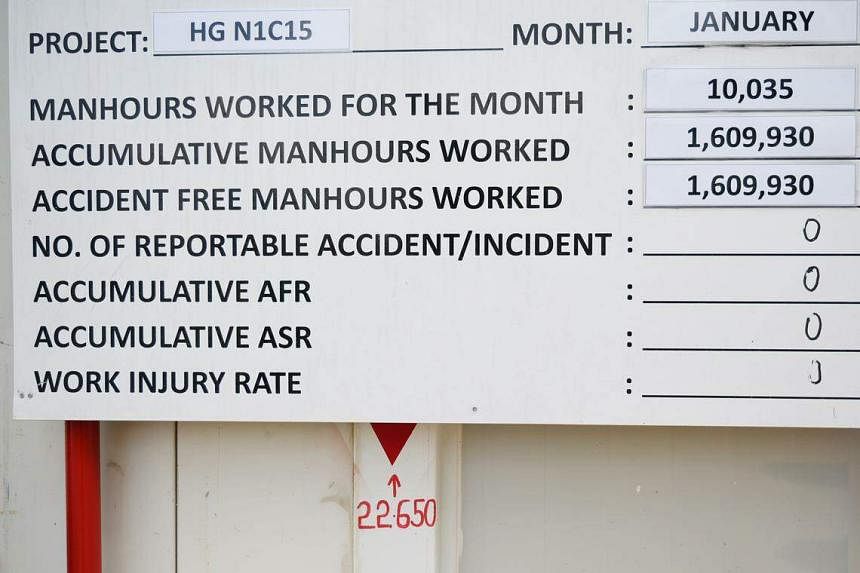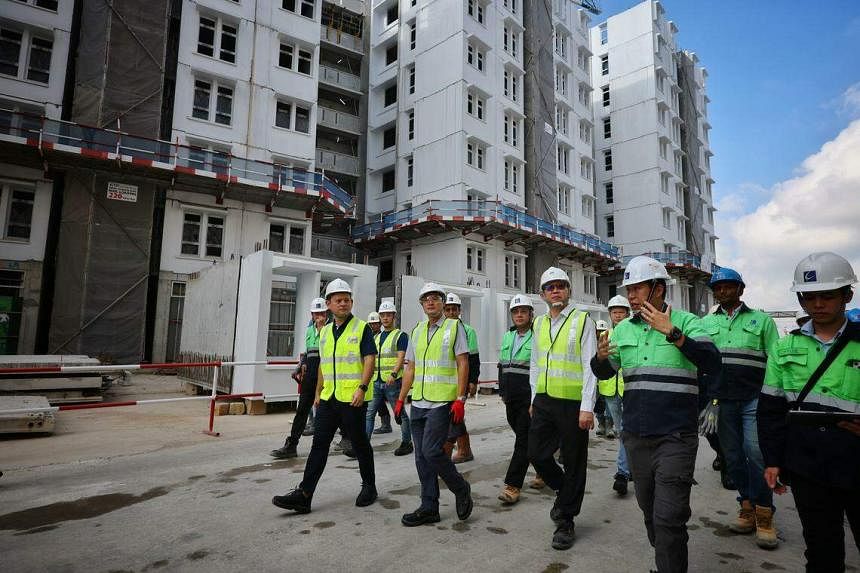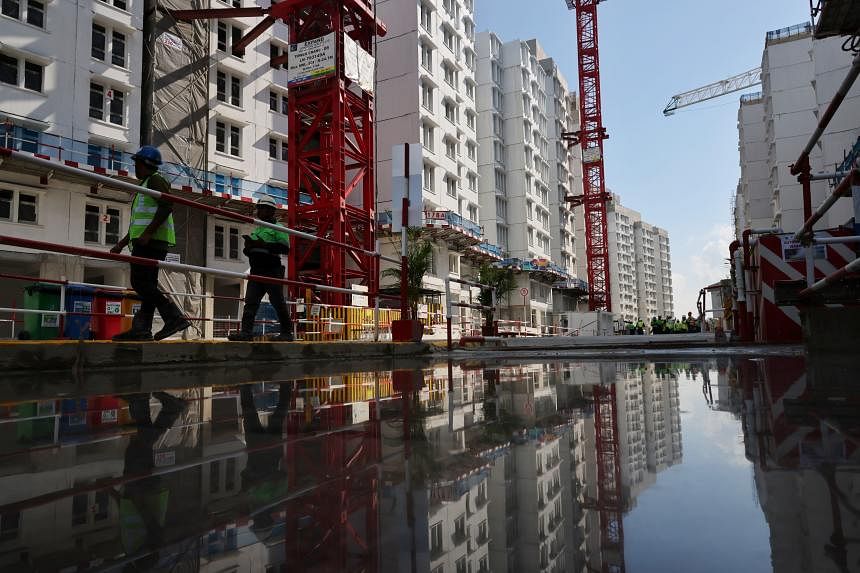SINGAPORE – Government agencies will place greater emphasis on safety in the evaluation of construction tenders called from April 1, raising the minimum weighting given to safety-related criteria.
Beyond past performance, contractors who demonstrate plans to adopt safer construction methods or deploy technology to improve risk monitoring and safety could also be assessed more favourably, the Building and Construction Authority (BCA) and the Ministry of Manpower (MOM) said on Feb 2.
The Government is Singapore’s largest developer, with the public sector expected to contribute about 55 per cent of construction demand in 2024. Some $18 billion to $21 billion worth of public-sector construction contracts are likely to be awarded in 2024.
For government construction projects valued at $50 million or more, agencies will give bonuses to main contractors with a good safety record. A portion of this money must be set aside to reward workers who uphold safety standards.
BCA and MOM said this is to incentivise a strong safety culture throughout the construction phase.
In a circular to the built-environment industry, the authorities said the total bonus will be pegged at 0.5 per cent of the awarded contract sum, subject to a cap of $1 million.
Agencies will have the flexibility to give a higher bonus, and they should establish the basis for the bonus payout primarily through an assessment of a worksite’s safety performance. This can be done monthly or quarterly.
The circular did not specify what percentage of the bonus must be set aside for workers.
With the new procurement requirements, MOM’s safety disqualification framework will cover smaller projects from April.
Right now, the framework applies only to projects valued at $3 million or more, and only to main contractors and their first-level subcontractors.
From April, it will apply to the main contractor of projects worth between $90,001 and $1 million.
For projects worth more than $1 million, the framework will apply to main contractors and all levels of subcontractors. This means any subcontractor that meets MOM’s disqualification criteria must be removed from the project.
Under the framework, companies with poor safety records are disqualified from taking part in public-sector construction tenders for three months to two years.
These are firms placed in MOM’s Business Under Surveillance programme, which helps companies with poor safety records to develop or improve their systems, and those temporarily barred from hiring foreign workers because they have accumulated too many demerit points for safety breaches.
In addition, all public-sector projects valued at more than $1 million must, from April:
- Identify and carry out workplace safety and health training specific to the activities and workers on site;
- Periodically report workplace safety and health performance, organise engagement sessions and roll out improvement plans for subcontractors who perform poorly; and
- Do risk assessments and ensure compliance by all subcontractors.
MOM and BCA said the aim of putting more weight on safety considerations during tender evaluations is to incentivise contractors to consider and propose safety improvements at the planning stage.
Government tenders are awarded based mainly on price and quality, with each component given a score.
Currently, the minimum weighting for safety-related criteria in public-sector construction tenders worth $3 million or more is at least 3 per cent of the overall score.

This will be raised to 5 per cent of the overall score and will apply to tenders above $1 million.
From April, public-sector construction tenders with a value of $3 million and above will also need to include requirements for the main contractor to use established workplace safety technology.
This includes an electronic permit-to-work system, an authorisation tool that controls selected work activities to ensure safe execution on site.
Plans to tighten safety requirements for government construction tenders were announced in May 2023 as part of a raft of measures to strengthen safety practices, especially in high-risk industries such as construction and manufacturing.
This was at the tail end of a nine-month heightened safety period imposed to curb a rise in workplace deaths in 2022, when 46 were recorded – up from 37 such deaths in 2021, 30 in 2020, and 39 in 2019.
The authorities said then that the industry would be consulted before details of the stricter procurement requirements were finalised.
In 2023, 36 workers died as a result of workplace accidents – a 21.7 per cent drop from 2022.
Singapore’s workplace fatality rate in 2023 fell to 0.99 deaths per 100,000 workers, the first time it has gone below the one fatality per 100,000 workers mark, aside from 2020 when Covid-19 disrupted work.
Prime Minister Lee Hsien Loong in a Facebook post on Feb 2 said this milestone was a stretch target Singapore had aimed to reach by 2028 and the Republic has made it five years early.
“We must work hard to keep this up and improve further. Many of the fatal incidents that sadly still happen from time to time are entirely avoidable. Also, serious workplace injuries have not come down as much as they should,” he wrote.
Speaking to reporters after a visit to a Housing Board Build-To-Order (BTO) site in Hougang Avenue 3, Senior Minister of State for Manpower Zaqy Mohamad said good procurement practices are a key fundamental of a safety culture.
“The Government, being a large procurer of services, such as construction... can make a difference,” he added.

Senior Minister of State for National Development Tan Kiat How encouraged private-sector developers to adopt the public sector’s best practices.
Singapore Contractors Association assistant secretary-general Jacob Wong said the new tender requirements will set a benchmark and help contractors, large and small, improve.
“For the bigger boys, they will have to reinvent or innovate. For the smaller ones, they cannot be ignorant and carry on with what they have been doing for the past 20, 30 years,” he added.
Mr Wong does not expect it to be a big step up for most companies. He added that the requirement for projects valued at $3 million and above to adopt established safety technology will lower the cost of such tools, as smaller firms will need to buy them to meet the new criteria.
Mr Wong said: “Even without all these small contractors coming in, the price has already dropped because more people are adopting it and there are more vendors coming up.”
Mr Von Lee, chairman and founder of Expand Construction, is confident his firm, which mostly builds public housing and infrastructure, already meets most of the new standards.
At the Hougang BTO project on Feb 2, the company displayed technology it had already adopted, such as an electric wheelbarrow, cordless power tools and drones for safety inspections.
While these have cost the firm hundreds of thousands of dollars, Mr Lee sees it as an investment. He also welcomed the idea of sharing workplace safety bonuses with workers.
“Safety is not just the company leadership’s problem,” he said. “It is a problem for everyone who steps into the construction site.”

